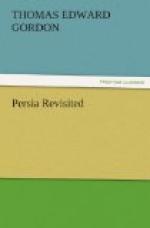As in England four hundred years ago, every place of worship is a sacred refuge; and the dwelling-house of the Chief Priest gives similar protection. This right of sanctuary continues in force throughout Persia; but to benefit by it for any length of time, money is very necessary, for without such aid, or when the supplies fail, starvation steps in to drive the refugee out. While in sanctuary, compromise and arrangement may be effected, so that the fugitive may be allowed to go unmolested, the relatives paying, or becoming ‘bail’ for, the blood-money or compensation agreed upon. A fugitive from justice, oppression, or revenge often claims the privilege of sanctuary in the house or premises of a local dignitary of influence, whose house would not be unceremoniously entered by pursuers, and this affords time either to meet the demands or accusations made, or to escape to a safer place.
At Tehran there is a big gun, said to have been brought by Nadir Shah from Delhi, and known as the Pearl Cannon. It is said to be so called from having had a string of pearls hung on it near the muzzle when it was on show in Imperial Delhi. This was probably the case, for we know that heavy guns in India were regarded with a degree of respect and reverence almost approaching worship. The gunners of the Maharajah Runjeet Singh, the Lion of the Punjab, used to ‘salaam’ to their guns, and to hang garlands of the sweet-scented champak flower, which is used in temples and at festivals, round the muzzles. The Pearl Cannon occupies a prominent position close to the Shah’s palace, and has always been recognised as possessing a semi-sacred character, and giving the right of sanctuary to those who touch it and remain by it.
I remember a regiment of infantry, represented by three hundred men who were ‘off duty’ and available for the demonstration, claiming the privilege of this great gun sanctuary after they had assailed the house of their Colonel in order to wreak their vengeance on him, as he was suspected of withholding their pay. The officer’s servants were warned in time, and closed the courtyard door, so that the rioters were unable to enter; but they relieved their feelings by battering the door with stones and damaging




